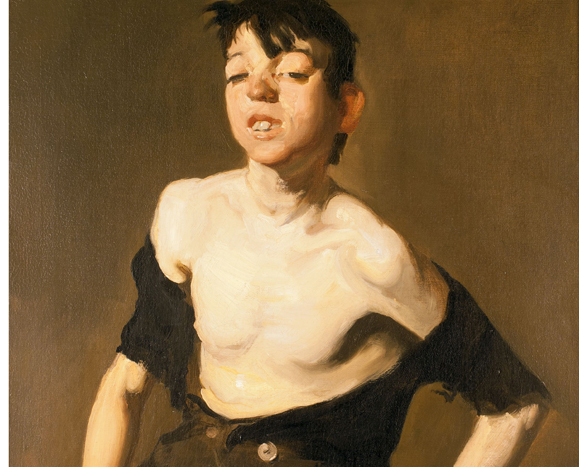The Ashcan School of artists were a group of realist painters who found inspiration in the seamy side of New York City. Tom Deignan looks at the Irish subjects who provided inspiration to these artists, as the Metropolitan Museum of Art mounts an exhibition of paintings by George Bellows (runs thru Feb. 18), one of the group’s foremost artists. The term Ashcan School was suggested by a drawing by Bellows called “Disappointments of the Ash Can.”
He stares out at you through half-closed eyes. His hair is mussed. His front teeth protrude and his nose and ear appear to have been battered in more than one brawl. His tattered clothes barely hang on his slight frame.
His name is Paddy Flannigan and right now, you can find this New York Irish street urchin in the most unlikely of places: The Metropolitan Museum of Art.
That’s because Paddy Flannigan is a realist painting by the great George Bellows, whose work the Met is celebrating through February 18, 2013. Bellows (1882 – 1925) is perhaps best known for his sinewy portraits of prizefighters and boxing matches from the early 20th century. But Bellows — and other members of the so-called “Ashcan school” of artists from the early 20th century – were fascinated by the Irish in both America and Ireland.
Paddy Flannigan (from 1908) is indicative of Bellows’ interest in urban subjects. It’s tempting to see this impoverished child as a lingering testament to Irish poverty in America. But for years critics have noted that there is a strength, even defiance to the boy, who was clearly no stranger to New York’s mean streets.
Other Bellows paintings such as the epic New York, Riverfront No. 1, Cliff Dwellers, and Blue Snow, The Battery, capture the horror and beauty of early 20th century New York City, home to so many real-life Paddy Flannigans.
For decades, American art had been dominated by rural nature scenes. The big city was seen as a crowded, ugly place devoid of beauty. The Ashcan artists changed all that.
Like Bellows, John Sloan (1871 – 1951) was also captivated by the New York Irish. Some of Sloan’s best-known work is a series of vivid portraits set in the famous Irish pub McSorley’s on East Seventh Street. In McSorley’s Cats, (1928) for example, the bar is crowded with smoking men wearing bowler hats, while the titular felines gravitate to a white-haired, mustachioed barman. Things seem a little more quiet, however, in McSorley’s Bar, (1912) as well as McSorley’s Back Room, from the same year.
Perhaps no other Ashcan artist was more captivated by the Irish than Robert Henri (1865 – 1929). Married to Irish immigrant and fellow artist Marjorie Organ, Henri made a series of fateful trips to Mayo throughout the decade of the 1910s. He produced a widely-celebrated series of paintings inspired by the people and landscape of Dooagh, Mayo, where Henri eventually purchased a house.
“[T]here was only one place outside of New York about which Henri felt strongly enough to purchase a second home, one place away from the city [where] he found such stimulating subjects that he could return to them repeatedly. That place was Ireland,” writes Jonathan Stuhlman, curator of American art at the Mint Museum of Art, in Charlotte, North Carolina. The Mint recently hosted an exhibition entitled From New York to Corrymore: Robert Henri and Ireland.
Not surprisingly, another Irish subject who fascinated Henri was his own wife, Marjorie Organ. In 1910, she posed for O in Black With Scarf. It’s a stunning study. The canvas is stark, heavily black, which heightens the effect of Marjorie’s alabaster skin, as do her ivory scarf and bold red hair.
Less well known, however, is Marjorie Organ’s own portrait of her husband, entitled “Robert Henri in Bed,” featuring the famous artist looking rumpled in bed, his hands covering his face.
All in all, the George Bellows exhibition at the Metropolitan Museum of Art is a valuable chance to become reacquainted with some of the most striking and vibrant art ever created – and to see how the Irish played a key role in one of America’s most important art movements.


This painting of this poor boy that must have suffered so much from poverty and neglect breaks my heart. But it brings home what many Paddy’s suffered in the early days in New York.
Life just flung at him, but never within his grasp!